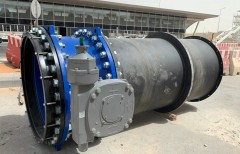News
Pipe Coupling Makes Portuguese Re-lined Main Leak Proof
Posted on 01st Jul 2007
The Lisbon water company EPAL is using a specialist coupling developed by Viking Johnson for terminating pipes that have been re-lined with a thin-wall PE liner.
The DN800 LinerGrip couplings for the rehabilitation work - on a concrete main at Ota, 50 km north of the city - were ordered by Portuguese contractor Vacqualiner, which is using the Subline® system under licence from the British company Subterra and in cooperation with Dutch company BAM Nellis Infra.
Explaining the reasons for the choice of LinerGrip, Vacqualiner's Hugo Santos said: "We needed to be confident that the PE liner was fully supported and held firmly in place when we returned the main to its operating pressure. This is particularly important when using thin-wall liners, because they rely on the strength of the host main and couplings for pressure retention."
Other successful applications of LinerGrip include 2.5 kilometres of concrete main through the historic centre of Haarlem in the Netherlands, and a 9-kilometre cast iron supply main to a service reservoir in the UK.
LinerGrip has an in-built gripping arrangement to hold the PE liner and prevent it retracting inside the host main due to changes in temperature or the Poissons Effect. It also provides a flanged end for connection to other pipework in the make-up piece.
The support provided by LinerGrip prevents damage by the shear forces arising as it emerges from the host main; and it 'seals back' onto the outside of the host, stabilising the entire fitting and preventing the ingress of ground water into the annulus between host and liner pipes.
Corrosion protection is provided by factory applied thermoplastic polymer Rilsan Nylon 11, which meets the stringent performance standards of WIS 4-52-01 (Part 1) for the highest adhesion, flexibility, penetration and impact resistance characteristics. As a result, LinerGrip products are well equipped to withstand transport, storage, site and corrosion damage, eliminating the need for further protection such as on-site wrapping.


